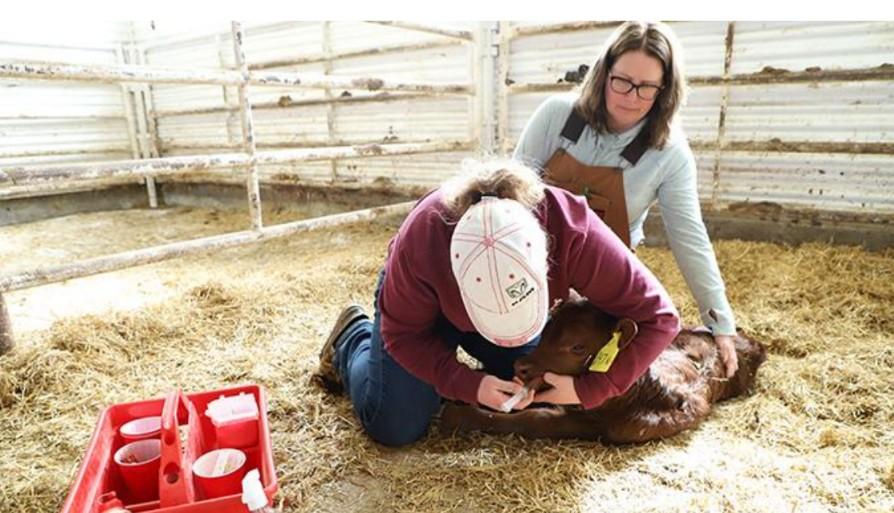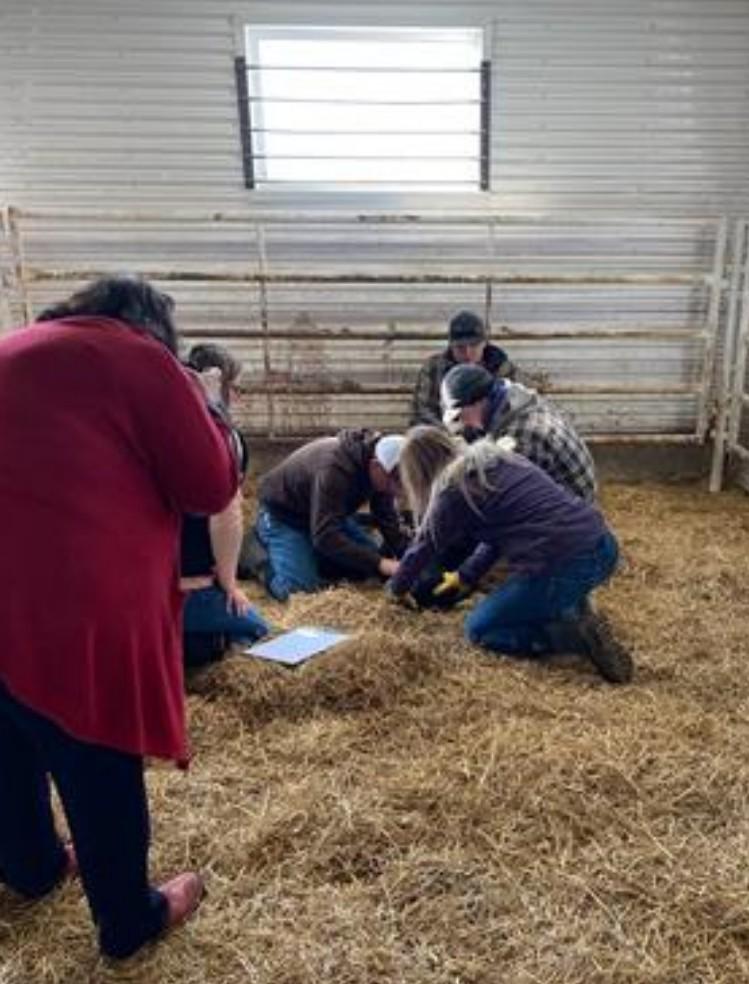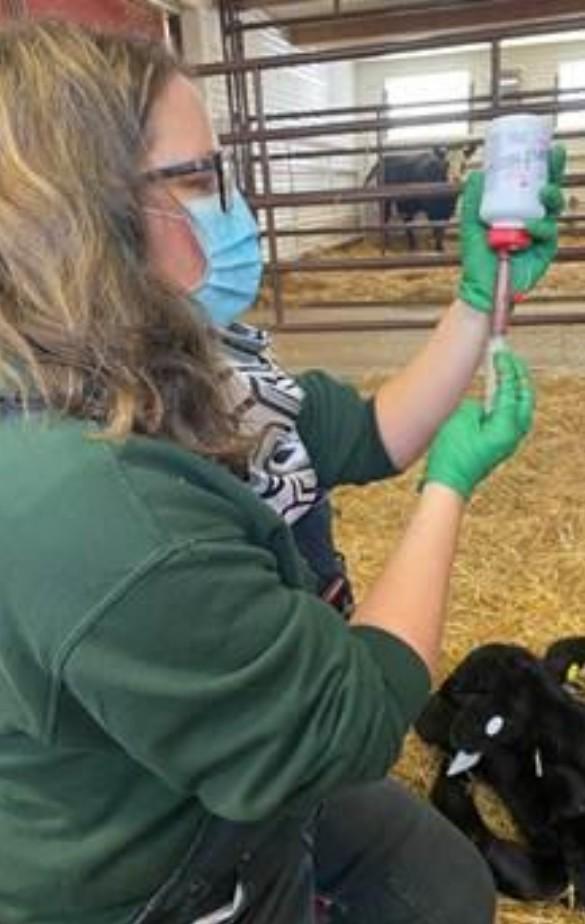
Nutritional wisdom: Why cows just aren’t that smart
July 2025
Research Team
Dr. Brenda Ralston and her research team at Lakeland College
Collaborators
Alberta Veterinary Laboratories Ltd. (AVL) (Calgary, Alta.)
Funder
The Natural Sciences and Engineering Research Council of Canada (NSERC)
Summary
Genetic advances in the cattle industry have resulted in animals with rapid growth rates and increased production efficiencies requiring critical minerals and vitamins (M/V).
As cow-calf producers strive to become more efficient through extended grazing programs such as fall/winter swath and bale grazing, the industry standard of providing freechoice M/V supplements to herds often results in sporadic consumption by individual animals. In most cases, this is insufficient to compensate for the decreased M/V availability in winter pasture, crop residue and stored feed. Can a neonatal supplement mitigate this deficiency?


Background
Genetic advances in the cattle industry have resulted in animals with rapid growth rates and increased production efficiencies requiring critical minerals and vitamins (M/V). As cow-calf producers strive to become more efficient through extended grazing programs such as fall/winter swath and bale grazing, the industry standard of providing freechoice M/V supplements to herds often results in sporadic consumption by individual animals. In most cases, this is insufficient to compensate for the decreased M/V availability in winter pasture, crop residue and stored feed.
Typically, a portion of your herd will eat twice the M/V that they require, another portion may not attend the M/V feeder at all, and the rest of the herd will fall somewhere in the middle. On average, the herd's consumption looks accurate because the herd is going through the right number of bags of M/V per week. However, the distribution across the herd is often not even and does not meet a portion of your herd's M/V requirements.
Drought has also been shown to reduce M/V content in forages and the increasing frequency of drought events due to climate change is likely to lead to greater M/V deficiencies in beef herds. Subclinical deficiencies, including poor immune function and reduced reproductive performance, are becoming more common, underscoring the need for a refined supplementation program strategy that could include an oral, individual animal, targeted supplementation.
There is a common perception amongst some cattle producers that beef cattle can sense when their diets are deficient in certain M/V, and they will eat free-choice M/V to replenish those deficiencies; we call this "nutritional wisdom," trust me, cows just aren't that smart!
Cattle are much like me at a buffet; they eat what tastes good and appeals to them, not necessarily the "broccoli" needed from a nutritional perspective. That being said, the one component that can either encourage or discourage free-choice intake, depending on its level in a free-choice product, is salt. Animals will seek out a certain level of salt in their diet, and intake of M/V can be encouraged with the addition of salt.


However, the flip side is also true that you can limit an animal's free-choice intake of creep feed by increasing the level of salt in the ration. The other factor to be considered is that the animal's only source of salt is not just from the M/V product you are providing them; it is also in your water and feed. The higher the salt content of your water, the less free-choice salt your animals will consume in a M/V supplement. Feedstuffs grown on saline soils and some plants such as Kochia will accumulate high levels of salt, which will also reduce the free-choice intake of M/V supplements offered, which include salt.
Another complicating issue when examining M/V supplementation and its availability to the animal is confounding factors such as mineral antagonism. The animal may be consuming the right amount of M/V but they are not able to utilize it to its full potential.
For example, copper is one of the most common nutrient deficiencies in grazing cattle, and its utilization by the animal after it has been consumed in a M/V supplement can be affected by antagonistic minerals such as sulphates and molybdenum that are found in an animal's feed and water, these reduce the available copper to the animal.
Methodology

The research team benchmarked neonatal M/V deficiencies (Vit A, Vit E, Selenium (Se), Iron (Fe)) in calves and their dams at calving in Lakeland College's (LC) purebred, commercial and dairy herds as well as local participating producers' herds.
Results indicate that 44 per cent of cows being supplemented M/V free choice before calving were deficient in Vit A and, to a lesser extent, deficient in Vit E and Se at calving; 67 per cent of calves were deficient in Vit A, 13 per cent in Vit E, 32 per cent in Fe and 94 per cent in Se at birth. These findings are consistent with Waldner et al. (2017), where 58.3 per cent of calves had below-adequate Vit A levels and were 2.8 times more likely to die, and calves deficient in Vit E (12.9 per cent) were 3.2 times more likely to be treated for scours.
Half of the LC study calves making up the treatment group received the oral neonatal supplement Vitaferst-Care manufactured by AVL (Se, Vit A, D, E

and B12) approximately 24 hours after birth when the calves had nursed and mothered up, and while producers were catching the calves to do other management procedures such as tagging and castrating. The control group of the calves received an oral saline placebo.
Results
Blood samples were collected from both groups and analyzed for M/V levels three days after treatment. We didn't see a significant increase in the M/V levels in the serum between the two groups; however, serum samples are not as accurate a measure as liver biopsies for some M/V, which may be why we didn't see a significant difference. In a similar study where serum samples were collected one-day post-treatment, there was a rise in M/V levels in the calves.
Why it matters
In further research, we would like to evaluate improving the M/V status of all animals in the herd by taking a systems approach. One way would be to boost the M/V levels with an oral drench or injection; several adult formulations are available in the marketplace. The intention is not to "make" more work for producers; rather, they could "top up" each animal's levels by providing a supplement when the cattle are handled in the chute.
At the time of handling, animals are often stressed and may also be getting a vaccination. Some research suggests that this is an optimal time to boost their M/V which may set the animals' immune system up for a more robust response to the vaccine administered. Adding individual supplementation is not to replace the free choice supplement but rather to "boost" each animal's M/V level at convenient times for the animals and producers.
The first step for producers is to evaluate their herd's nutritional status through evaluating their production records and consulting with their nutritionist and veterinarian. If M/V intervention is required, the team can help you develop a strategy for your management system.
